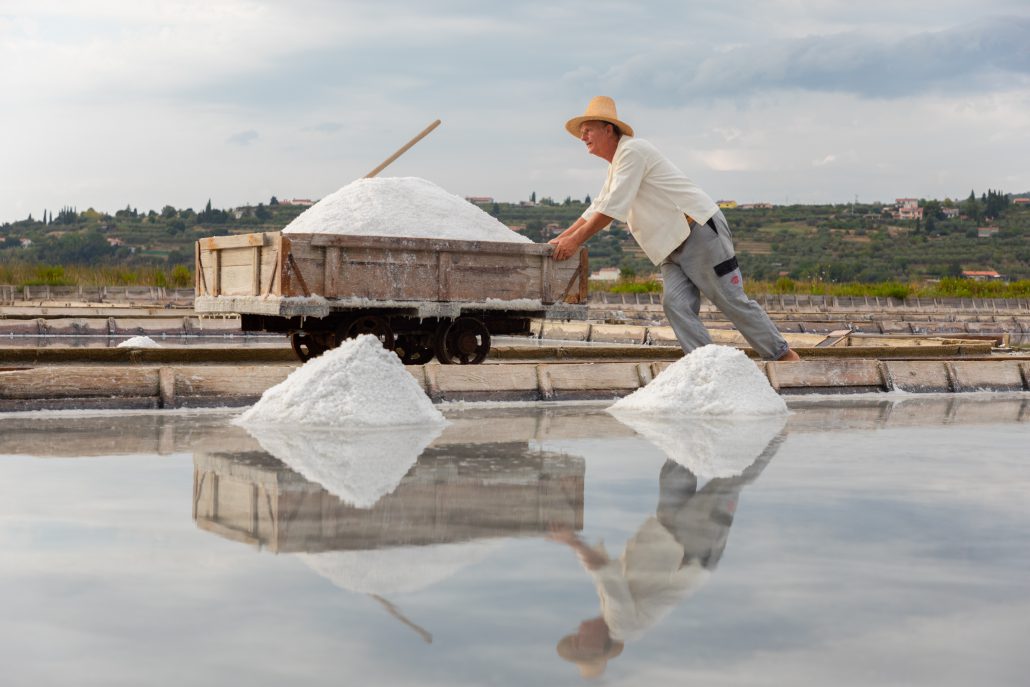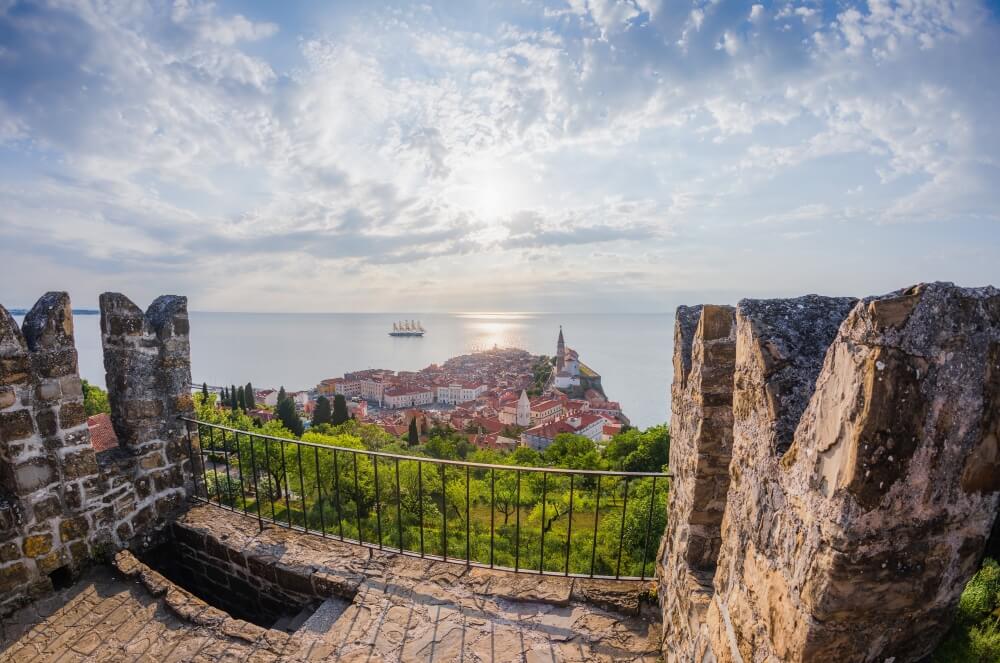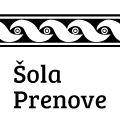Through the most beautiful town by the sea
Meet a top violinist. Enter the house of an unusual love story. Walk up 146 steps to the bells. Get down to the lighthouse.
In the centre of the violinist's town
Tartini Square (1), named after the famous composer and violinist Giuseppe Tartini, is the biggest square and the best starting point for exploring the specifics of the town. The municipal palace (2) houses the Tourist Information Centre (3) where you can get more information for your trip. Start it right in the square surrounded by medieval palaces. See the exhibition in the Town gallery in Loggia (4). When you look at Benečanka – the Venetian House (5), think of beautiful love stories. The Tartini Monument (6) should encourage you to enter Tartini House with the memorial room of the great virtuoso (7).
A Tip: When visiting Tartini House, look for the La bottega dei sapori inn, where you can indulge in typical Piran dishes including fresh fish and home grown vegetables.
The most beautiful veduta on the wall
From Tartini Square, head to the steep Rozmanova ulica street (not suitable for people with mobility issues). The Rašpor Gate (8) from the 15th century is still preserved there. It is one of the three town gates from an almost completely preserved wall that you will soon be approaching. The town walls (9) with their seven towers are really worth seeing so venture up there. Do not miss the exceptional views and photo opportunities. From here, the most beautiful panorama of Piran can be seen.
Among churches of Piran
There are as many as 10 churches in Piran. After visiting the walls, continue along Ulica IX. korpusa street and then turn left into Bolniška ulica street, where the Minorite Monastery is located (10). The cloister, which is a part of the monastery, hosts events such as the Tartini Festival due to its exceptional acoustics. Next to the monastery is St. Francis’s Church (11) with paintings by Venetian painters from the 17th and 18th centuries. You will also find the small Church of Our Lady of the Snows here (12), once a private chapel of a wealthy Piran citizen. Nearby is the baroque Church of Our Lady of Consolation (13).
To the lookout point
Take the steps to the top of Piran, from where you can enjoy views of the sea and three countries. The hill has been fortified with retaining walls and stone arches since the 17th century. At the top of the lookout is St. George’s Cathedral (14), the biggest of the Piran churches, with seven marble altars and a richly painted wooden ceiling. Part of the church complex is the octagonal baptistery (15), in which Giuseppe Tartini was baptized. The highest dweller in Piran is the Archangel Michael. With his turning in the wind at the top of the bell tower (16) he predicts the weather. The bell tower is 46.45 meters high. Climb its 146 steps and expand your views of the town and distant horizons.
Down to Punta and the sea
We descend along the Pusterla to Prešeren embankment by the sea. It leads us to the tip of the Piranian peninsula – the Piranian punta or the Cape Madona (17). Here is the deepest point of the Gulf of Trieste.
There is a neo-Gothic lighthouse (18) on Punta with an apartment for a lighthouse keeper. The stone lighthouse is open for visitors. A part of the stone fortress, which was once embedded in the town walls, is also the church, which was dedicated in 1274 to St. Clement, patron saint of sailors. In 1632, due to infectious epidemics, it was dedicated to Our Lady of Health.
Through many Piran gates
From the embankment, go past Turšičev trg square and through the Milje Gate (20) into Gregorčičeva ulica street. It brings you to Prvomajski trg square (21), which used to be the central square of Piran. It has a stone platform with a rainwater collector. Continue on to Judovski trg (Jewish Square) (22) with St. Stephen’s church, one of the oldest churches in Piran. Return to Tartini Square after finding more passages through the remaining preserved town gates (23). Both Verdijeva and Savudrijska ulica streets bring you to the Dolfin Gate. Obzidna and Partisanska ulica streets take you to the Central Gate. Find the Milje Gate near Turšičev trg square. A walk along Kidrič embankment takes you past the Trevisini Palace (26) to St. George’s Gates. Here you return to Tartini Square (1), where you began your exploration of the most beautiful Slovenian coastal town.
A Tip: Treat yourself to a ligh meal and a glass of Istrian Malvasia in the local Cantina on Prvomajski trg square. Find a souvenir in Čokoladnica (the Chocolate House) with a rich selection of handmade sweets or in the Venetian House, where you can choose between products with salt from the Piran saltpans.
Suggestions for a hike
To the Sečovlje saltpans for good feelings
Piran is a town that prospered on salt. Visit the famous Piran saltpans. See the traditional, 700-year-old salt production method. Enter the saltworks museum in the house where saltworkers’ families once lived. Observe the life of birds in the saltpans – there are more than 300 species here. Experience the healing effects of brine and salt mud in the unique Lepa Vida outdoor wellness centre. Enjoy the effects of thalassotherapy.
More information: TIC Piran

1. Tartini square
The smaller harbour, the town’s inner port for fishing boats, was backfilled with sand in the 19th century. Thus, a spacious square was formed around which all major institutions are lined up. The square was named after the famous Piran man, the violin virtuoso and composer Giuseppe Tartini (1692 – 1770). The square with an elliptical shape was the final turnaround point for the electric tram that connected Piran and Portorož in the first half of the 20th century. Today’s image of the square with a white Istrian stone platform was designed by architect Boris Podrecca.
2. Municipal palace
At the end of the 13th century, the Ventians built a town house in the Romanesque – Gothic style outside the then town walls. Its façade was full of built-in coats-of-arms and plaques. At the end of the 19th century, a new municipal palace was built. Here, the stone figure of a lion with an open book takes us back to the times of the Venetian Serenissima and old town houses. The palace houses the Domenico Tintoretto meeting room, which is decorated with the artist’s large canvas “Mary with Child and Piran Town Fathers”.
Tartinijev trg 2
3. Piran Tourist Information Centre
The centre in the municipal palace is an excellent starting point for getting to know Piran, Portorož and Istria. Here you can get informational and promotional materials or arrange guided tours of the town and the hinterland.
Tartinijev trg 2, T: 05 673 44 40
4. Loggia
On location of today’s Town Gallery, there used to be an old town loggia connected to the town hall and St. Jacob’s Church. It was the gathering point of town lords and home to an office of auditors who guarded municipal property. The Town Gallery is an important exhibition space of modern art and a venue for high-profile events such as the Piran Days of Architecture.
Town Gallery, Tartinijev trg 3, T: 05 671 20 80
5. Venetian house (Benečanka)
The oldest preserved house in Tartini Square was built in Ventian Gothic style in the 15th century. There is a built-in stone slab with a standing lion and the inscription “Lassa pur dir” (Let them speak) between the windows of the second floor. Legend has it that the inscription is related to a love story. A well-off Venetian merchant is said to have built a house for a beautiful young woman from Piran. The inscription supposedly reminded the gossiping citizens how little he cared about their rumors. Today, there is a shop selling top-quality Slovenian sparkling wines and crystals on the first floor of the house, while the second and the third floor boast prestigious accommodation. One apartment is named after the Venetian merchant Del Bello, the other one is Margaret, named after the beautiful Piran woman.
Ulica IX. korpusa 2, T: 041 681 845
6. Tartini monument
Giuseppe Tartini, born in 1692 in Piran, was one of the greatest violinists of his time, a respected composer and an original music theorist. Upon the 200th anniversary of his birth, the townspeople wanted to erect a monument in his honour, but the work was protracted and the larger-than-life bronze statue of the master was mounted on the high pedestal in 1896. The monument is the work of the Venetian sculptor Antonio Dal Zotto; the base was made by the Trieste stonecutter Antonio Tamburlini.
7. Tartini house with a memorial room
One of the oldest buildings in the town, mentioned as early as 1384, belonged to the noble Zangrando family at the time of Tartini’s birth. Caterina Zangrando, Giuseppe’s mother, belong to this family. Today, the artist’s birthplace houses the memorial room with valuable musician’s object such as the death mask, the violin, the music score pages and letters. The veduta hall with interesting murals is also worth visiting. The house is also the headquarters of the “Giuseppe Tartini” Italian Community.
Cankarjevo nabrežje 3, T: 041 671 297
8. Rašpor gate
The oldest city centre was probably walled up in the seventh century. The part of the wall that surrounded the oldest part of the town in the area of the cape did not change in its course, it only needed to be thoroughly restored several times. In the final phase of expansion, in the early 16th century, the so called third wall encircled the whole peninsula. In the meantime, a second wall was built, the remains of which is the preserved Rašpor Gate.
Rozmanova ulica
9. Town wall
Piran’s town walls initially surrounded only the old town core in Punta. As the town began to expand towards Mandrač, it continually included new quarters forming outside of the walls. Due to this expansion and attacks by external enemies, the walls were upgraded. The remains of the first and second town walls are now embedded in the town centre and you can see them as you stroll through the streets of Piran. The most extensive preserved remnant of the wall with defensive towers on the slopes of Mogoron, which gives the town a characteristic cityscape, is of exceptional historical value. The third wall, completed in the 16th century, embraced the entire peninsula.
www.wallsofpiran.com, T: 05 671 03 90
10. Minorite monastery
The Minorite Monastery of St. Francis was probably founded before 1301, when the Minorites had already begun building the church. It houses a lot of music literature, while the old monastery library boasts books from the 15th century. The Minorite brothers who manage the monastery church, offer spiritual care and organize religious retreats, still live here. The Cloister is one of the most acoustic venues in Slovenia, where many top music events have been taking place for many years. From the cloister, there is an entrance to the Pinacotheca, where paintings by Venetian artists are put on display.
Bolniška ulica 30, T: 05 673 44 17
11. St. Francis church
The church in the Minorite monastery complex, dedicated to St. Francis of Assisi, was built in 1318. Its present interior dates from the 17th and its exterior dates from the 19th century. The church is decorated with statues and paintings by Venetian artists and boasts an organ from 1897. Inside the church, there is also the tomb of the Tartini family among the 32 tombs under the paving. The bell tower with three bells from the 13th century is located behind the church.
Bolniška ulica
12. The church of our lady of the snows
This smaller church, built in the 15th century with the legacy of a wealthy Piran woman, has a painting of Mary of the Snows above the entrance with a scene of a miracle – the August snow in Rome. The prescious oil painting with fretted frames has been preserved from the time of a Baroque-style renovation in the 17th century. During the restoration they discovered two valuable paintings from the mid 15th century in the tempera on wood technique. The paintings “Crucifixion” and “Annunciation” are a unique example of Gothic table painting in Slovenian Istria.
Bolniška ulica
13. The church of our lady of consolation
The Baroque church stands on the site of the former medieval church of St. Michael. It boasts paintings with scenes from the legend of St. Augustine and rich wooden inlays. The wall above the main entrance door is adorned with Brustolon’s large wooden carved frame from the early 18th century with the painting “Mary with Child”.
Ulica IX. Korpusa 20, T: 05 673 34 40
14. St. George's cathedral
The church, built in the 14th century, got its present appearance after the Baroque restoration in the 17th century. It is named after St. George, the town’s patron saint, who supposedly saved Piran from a violent storm in 1343. In addition to seven altars and a painted ceiling, the interior of the church is decorated with canvases of the Venetian school, Gothic crucified Jesus from the beginning of the 14th century and statues of St. George and St. Nicholas. There was the first Christian church in the period between the 6th and 7th centuries on the site of the present church.
Adamičeva ulica 3, T: 05 673 34 40
15. Baptistery of Saint John the baptist
The baptistery, built during the renovation of the church complex in 1650, replaced the medieval baptistery that originally stood in front of the church. During the construction of the new one, the floor plan of the old baptistery, the domed roof and the skylight were preserved. A window and a Roman sarcophagus from the 1st century were also transferred to the new baptistery. This oldest element in the baptistery was converted into a baptismal font. On two sides of the stone is a relief of a dolphin and a winged boy – an ancient symbol of the transition to the afterlife.
the church complex, Adamičeva ulica 3
16. Bell tower
The bell tower, added in the 17th century, is a reduced copy of the bell tower of St. Mark in Venice. It is 46.45 m high and has four bells. The oldest, cast in 1477, still announces full hours today. The bell tower can be climbed by stairs with 15 platforms adorned with images of angels and inscriptions in Hebrew, Greek and Latin.
church complex, Adamičeva ulica 3
17. Punta - Cape Madona
When you stand on Punta and look in the direction of Venice, you can only suspect what is going on in the sea, less than 20 meters from the shore. The natural monument of Cape Madona is home to an incredibly diverse multitude of underwater plants and animals. It extends to a depth of 38 meters, which is also the deepest point of the Gulf of Trieste. This puzzle of the sea is called by many underwater Triglav.
Prešernovo nabrežje
18. Piran lighthouse
The lighthouse on the very tip of the Piranian peninsula is part of the associated buildings, which in addition to the lighthouse and the lighthouse keeper’s apartment consist of the Church of Our Lady of Health and the tower. The famous stone fortress was built in 1617 and was part of the former town walls. It became a lighthouse between 1871 and 1872, when a red light was mounted on it and a small stone building was built next to to house the engine room. The apartment for the lighthouse keeper was built on the fort in 1874. It is built of white slabs of Istrian stone.
Prešernovo nabrežje 20
19. Our lady of health church
The church on Cape Punta, which leans on the lighthouse and the former fortress, was mentioned as early as the 13th century as the church of St. Clement, the patron saint of sailors. In 1631, after the plague epidemic, it was renamed the Our Lady of Health Church. The medieval church was rebuilt in Baroque style in the middle of the 18th century. The ceiling of the nave boasts a Rococo stucco. The main part is the relief depicting the Caritas (Love) allegory.
Prešernovo nabrežje
20. The Milje gate
Of the entire Piran walls on the sea side, only the Renaissance roundel from the year 1508 and a part of the walls with some of the gates are preserved. Among the oldest is the semi-circular Milje Gate with the tower, converted into a residential house.
Turšičev trg 1
P21. Prvomajski trg square
The main streets of Piran converge on the square that was once called the Old Square – Piazza vecchia. Therefore, it was once considered the main town square. In the middle of it is a stone rainwater reservoir, which was built after a severe drought in the 18th century. Gutters from the roofs of the surrounding houses were led into the collector. Water seeped through stone blocks which cleaned it and was then collected in a large fountain. It was pumped up with a hand pump, which has been preserved to this day. The entrance to the square is adorned with statues of Justice and Law.
22. Jewish square
Jewish Square was modelled upon the Venetian Jewish ghetto. One of the three atriums once had a large underwater fountain which gathered rain water from the nearby roofs. Today a large, eight-sided plate of white stone stands in its place, along with the four smaller, pierced plates through which the water poured into the fountain. It was all made by the famous sculptor of Piran, Janez Lenassi. St. Stephen’s Church, one of the oldest churches in Piran, is located nearby. The staircase behind the altar leads to the high attic belonging to the Brotherhood of a Happy Last Hour.
23. Town gates
In Piran, seven town gates have been preserved, which allowed the entrance
through the walls. The Dolfin Gate, erected in the 15th century, is the best-preserved Gothic gate in the town. It is decorated with a crest depicting three dolphins. The Field Gate also dates from the 15th century. Once, a church connected to the town hall stood next to it. The Baroque gate of St. George, restored in the 17th century, is fused with a courthouse built on the site of a former grain and flour warehouse. In addition to the oldest Milje Gate and the first Rašpor Gate built in the Gothic style, which you have already seen on a walk, there is also the Second Rašpor Gate with a pointed arch along the narrow part of the wall with towers, and the Renaissance Marčana Gate from the 16th century.
24. Trevisini palace
The mighty Neoclassical palace of Barbojo Fonda Trevisini combines the surnames of important Piran people. The bulk of the funds for its construction was contributed by the high salt official Giuseppe Barbojo, the owner of many salt fields, the president of the salt council of the Twenty and for some time also the mayor of Piran. The Palace but was built in the years 1824-1826. Now it bears the name of the latest majority owner – the members of the Trevisini family.
Kidričevo nabrežje 2
- 11. Tartini square
- 22. Municipal palace
- 33. Piran Tourist Information Centre
- 44. Loggia
- 55. Venetian house (Benečanka)
- 66. Tartini monument
- 77. Tartini house with a memorial room
- 88. Rašpor gate
- 99. Town wall
- 1010. Minorite monastery
- 1111. St. Francis church
- 1212. The church of our lady of the snows
- 1313. The church of our lady of consolation
- 1414. St. George's cathedral
- 1515. Baptistery of Saint John the baptist
- 1616. Bell tower
- 1717. Punta - Cape Madona
- 1818. Piran lighthouse
- 1919. Our lady of health church
- 2020. The Milje gate
- 21P21. Prvomajski trg square
- 2222. Jewish square
- 2323. Town gates
- 2424. Trevisini palace





